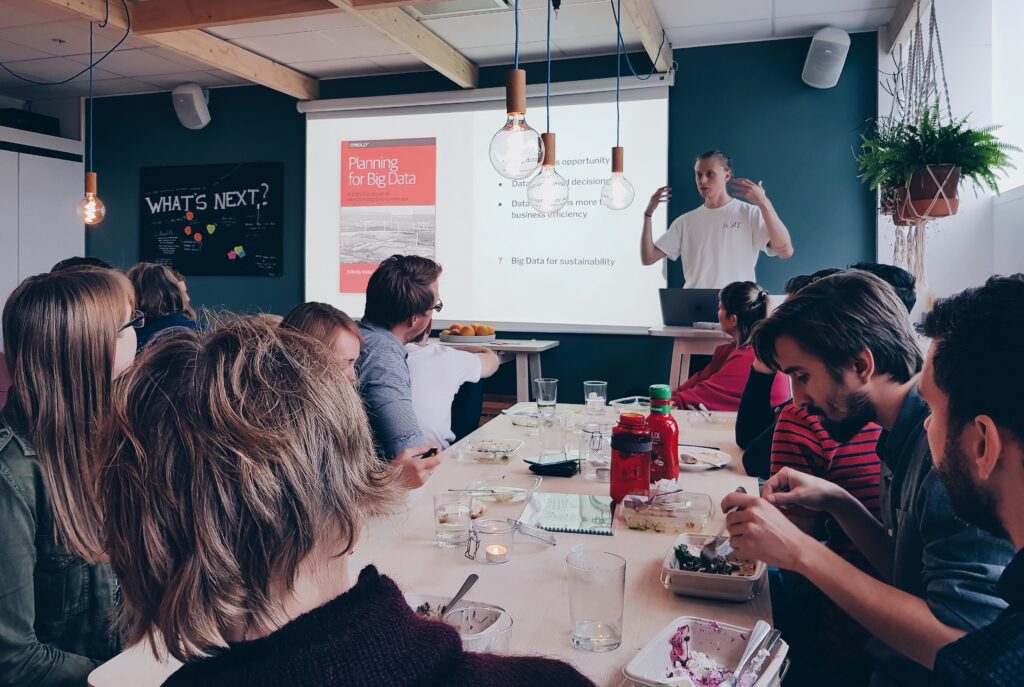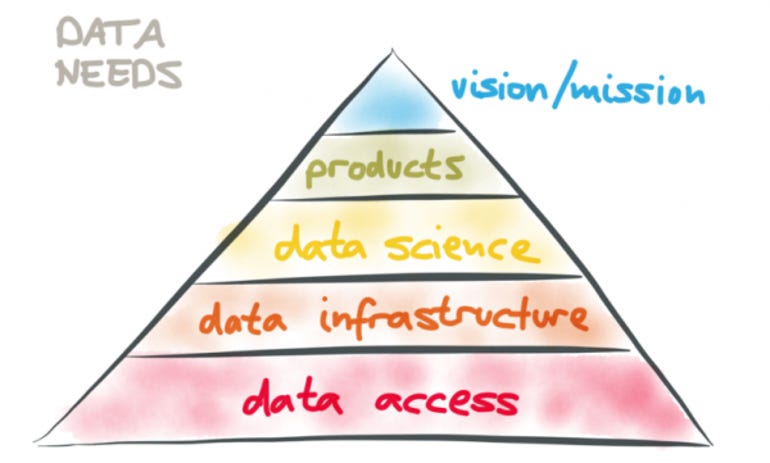It is now about 4 years ago I did my master thesis on data-driven design for sustainable development. My thesis was in short, an investigation of how we could leverage data and technology to more easily align the sustainability perspective with the business perspective in the world of design. Since then, I have been working on digital product development projects involving big data and how to use it for new business opportunities. What do I think now?
First of all, for the survival of most current species of planet Earth, including humanity, we need to change our system. If the whole world’s population would fully commit to creating a sustainable circular economy and put all our resources into accomplishing that, I think it would go pretty quick. Regardless if this change would happen through a top-down approach of policy-making or a bottom-up approach of individual action, it is about people and how people have to make this systems-change happen. Thus, I want to revisit this topic from my thesis and write about how we could nourish this shift in people, by taking advantage of data and technology.

My thesis was a naive piece of work to begin with, abstractly speculating on big complex societal systems with academic and hypothetical enthusiasm. Although, I don’t think being naive is inherently a bad thing. I actually think we need more of it. That is why I will continue in the same spirit to speculate further on the prospects of the future, and not care too much if my feet starts to float off the ground.
So let’s dive in. What would be an optimistic, yet perfectly conceivable way to reach a utopian data-driven future? and what could it look like?
Joern Fischer et. al. argue that the biggest obstacle to sustainable development is no longer a lack of knowledge about the problems, but rather resistance towards change and passiveness of not acting on existing knowledge to work towards a sustainable future. We need to change our behaviour, and we know it, but changing behaviour is a tough nut. We are so paralysed by our present comfortability that it prevents us from relating to the more distant future consequences.
To find what is the best way to cause behaviour change, a group of researchers founded this model, categorising human behaviour by the level of difficulty to change, and the potency of that change [1].

In our utopian development scenario, let us focus on influencing people. People and their values and beliefs, because it holds more promise of profound change, even if it is harder to accomplish. I am a firm believer in policy-making to bring about change as well, but democratic governments today are too passive in complying to the global goals because they are worried about what voters would think if they make drastic changes in their short 4-year mandate period. So in the end, policy is also subject to peoples values and beliefs. Thus, I conclude that people’s morality is the very core of the issue we want to target.
Although we know the basics of the impact our choices have, like that it is bad to eat animal products and burn fossil fuels, it is still often not straight-forward to know what is a more sustainable decision in a given situation. Supply chains can be extremely complex and difficult for producers to control, not to mention the maze of being a consumer. A product can also have unexpected secondary impacts. In designer and consumer eyes, a product can be intended to have a sustainable impact, but from a wider perspective it might in fact have an unexpected harmful influence through peoples behaviour, and thus contribute to an overall negative footprint. Behaviour is difficult to predict, and here is where leveraging data comes in.
Basically, there is a humongous and ever increasing amount of data from tracking our behaviour and its consequences in the world. Businesses and organisations around the world have already found that efficiently extracting relevant information from these noisy big data sources can introduce new value and a competitive advantage. So, let’s then use that information to find what behaviour, values and beliefs we should inspire, and in what moments to do so, for a sustainable impact.

Seems I’m into triangles. Anyhow, referring to the model above, there are of course layers to what needs to be in place for the discussed scenario to become a reality. In this post I am very much discussing a futuristic vision, where I assume that the foundational layers of this pyramid are already established.
In smaller scale, we are however already seeing big data sources being crunched and used for making sustainability-informed decisions. See for example the UN global pulse innovation initiative. Most of these projects are about equipping leaders and organisations with more knowledge to base their decisions on. The main difference to my scenario is that I would like to see everyone everywhere having easy access to relevant information in the moment that it matters. Ubiquitous, effortless and real-time.

We are of course also seeing many examples how businesses are leveraging big data to extract value and benefit to their customers, such as the model above illustrates. However, data-driven innovation expert Alistair Croll claims that the incorporation of big data into our society enables opportunity for something far more important than mere business efficiency. He claims the future of big data and data analysis could mean a new era for humanity where high speed laps around the data feedback loop – from big data to valuable insights – will become a normality for businesses and governments [2]. A very advantageous step forward would thus be if the public and private sector start working more together, and do so internationally [3].
A requirement in this context is of course also that the data analysis and predictions are air-tight trustworthy. To make sure that the cluster is not compromised and that the recommended actions are not biased to any other agenda than sustainable development, blockchain technology comes to the rescue! A fully decentralised network, where every node of the network and every user who is interacting with the network would own the same information. You could then by system-design trust that the disclosed information and given recommendations are for the public good.
Still a bit abstract and optimistic you say? How would that actually work in practice you wonder?
Machine learning has already for some time been a key component of extracting value from complex data sets. Human exploration of data is also often still necessary in finding how to get the best out of it. But with some time, let’s say we will be able to train our models to be genius data gurus by themselves, each being an expert extractor on their respective data quality or type, and all the relevant data in the world – from private and public organisations alike – will somehow be linked and interconnected for our little gurus to analyse and cross-reference with each other. This all-knowing cluster is then easy accessible to any company or organisation through an open source API, as well as user-friendly cross-platform interfaces. Simsalabim.
A purpose of using data and AI as an online retailer today can be to recommend a next purchase, which a customer might be interested in. This could be based on mere similarity to their latest purchase. But, with access to more information about the target customer, looping through the data supply chain, extracting insights from a nebula of behavioural data, they can make even more precise predictions and increase the likeliness of the desired action. Accordingly, we want to add the parameter to find and encourage what specific action that would be most sustainable for each context.
By applying a sustainability perspective into this decentralised data supply chain, navigated by our sustainability data gurus, it is then predicted what actions or behaviour that would be the most sustainable in any given context. Every human can then connect to an interface right in front of them what is the most sustainable decision for them to make there and then, black and white.
Some examples:
- The administration of a country is about to vote for or against a new law. The proposal has been automatically scanned and analysed by an application trained with relevant data, and each member of parliament gets it clearly visualised in front of them on a screen on what is predicted to be the most sustainable option and why.
- A designer is in the middle of designing a landing-page for a big digital user platform. The software she is using to design the landing page is featured with an algorithm, providing her with subtle cues at every step of the design process, of what would be a beneficial direction based on sustainability-biased data analysis.
- You are standing in the supermarket, contemplating on whether to buy oat milk or almond milk. Projected in the air in front of you, you find the environmental impact of each decision, together with other stats from the supply chain, and clearly highlighted you can find the recommended choice from a sustainability perspective.
- Scrolling through a list of funds and stocks to invest in, you are trying to decide where to place your money. Through corresponding stats and recommendations, you can clearly see what are the most sustainable decisions. This is perhaps provided by a third-party application partnering with all the major banks and calculating the footprint of each investment.
With the progression of AI, blockchain, big data analysis, data privacy and the semantic web (all the buzzwords 😏), these context-aware nudges will then shape our values and beliefs into a new normality, and we embark on a journey towards a sustainable society. This could also go to even deeper levels than in situations of humans picking choice A, B or C. Perhaps, with enough accuracy, ethics and trust, this decision-making algorithm could even be put in charge of all our consumer decisions. Like an automated sustainability butler that works for a bigger agenda, helping us neutralise our impulsive and greedy human behaviour.
Fingers crossed we don’t end up building Skynet!
[1] Joern Fischer, Robert Dyball, Ioan Fazey, Catherine Gross, Stephen Dovers, Paul R Ehrlich, Robert J Brulle, Carleton Christensen, and Richard J Borden. Human behavior and sustain- ability. Frontiers in Ecology and the Environment, 10(3):153–160, 2012.
[2] Alistair Croll Mike Loukides Julie Steele O’Reilly Radar Team, Edd Dumbill. Planning for Big Data. O’Reilly Media, 2012.
[3] Hubert Gijzen. Development: big data for a sustainable future. Nature, 502(7469):38–38, 2013.
[4] Martin Kleppmann.
[5] Lester D’Cruz, Ph.D, Big Data Analytics Funnel for the Entire Supply Chain, 2021. https://media.licdn.com/dms/image/C5612AQFWNXpX9YR0bQ/article-cover_image-shrink_423_752/0/1622876677784?e=1713398400&v=beta&t=53ygLwWGhQFPVj5VpqhIYMtXuGu6FginbYaPKNH3qCU